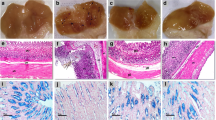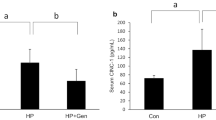Abstract
Helicobacter pylori, present in the stomach lining, is a Gramnegative bacterium that causes various gastrointestinal diseases, including gastritis and peptic ulcers. Propolis is a natural resinous substance collected from a variety of plants, and contains several natural bioactive substances. The aim of this study was to investigate the anti-inflammatory and antioxidative effects of Korean propolis on H. pylori-induced damage in the human adenocarcinoma gastric cell line. The propolis used in this study was obtained from the Korea Beekeeping Association in South Korea. The expression of pro-inflammatory interleukins (ILs), such as IL-8, IL-12, IL-1β, tumor necrosis factor alpha, cyclooxygenase-2, and inducible nitric oxide synthase, which was increased after H. pylori infection, significantly decreased in a dose-dependent manner upon pretreatment with Korean propolis, because of the suppression of mitogen-activated protein kinases and nuclear factor kB pathway. The anti-oxidative activity of propolis was assessed using the 2,2-diphenyl-1-picrylhydrazyl hydrate free radical assay. Korean propolis showed significant anti-oxidative effects via reactive oxygen species scavenging. In addition, pretreatment with Korean propolis upregulated the expression of anti-oxidant enzymes through Nrf2 signaling activation. These findings indicate that the use of Korean propolis, which has anti-inflammatory and anti-oxidative effects, can be promising for the prevention of H. pylori-induced gastric damage.
Similar content being viewed by others
References
Ahn, M.R., Kumazawa, S., Hamasaka, T., Bang, K.S., and Nakayama, T. 2004. Antioxidant activity and constituents of propolis collected in various areas of Korea. J. Agric. Food Chem. 52, 7286–7292.
Aihara, M., Tsuchimoto, D., Takizawa, H., Azuma, A., Wakebe, H., Ohmoto, Y., Imagawa, K., Kikuchi, M., Mukaida, N., and Matsushima, K. 1997. Mechanisms involved in Helicobacter pylori-induced interleukin-8 production by a gastric cancer cell line, MKN-45. Infect. Immun. 65, 3218–3224.
Backert, S. and Naumann, M. 2010. What a disorder: proinflammatory signaling pathways induced by Helicobacter pylori. Trends Microbiol. 18, 479–486.
Barroso, M.V., Cattani-Cavalieri, I., de Brito-Gitirana, L., Fautrel, A., Lagente, V., Schmidt, M., Porto, L.C., Romana-Souza, B., Valenca, S.S., and Lanzetti, M. 2017. Propolis reversed cigarette smoke-induced emphysema through macrophage alternative activation independent of Nrf2. Bioorg. Med. Chem. 25, 5557–5568.
Blaser, M.J. and Atherton, J.C. 2004. Helicobacter pylori persistence: biology and disease. J. Clin. Invest. 113, 321–333.
Blois, M.S. 1958. Antioxidant determinations by the use of a stable free radical. Nature 181, 1199–1200.
Bodger, K. and Crabtree, J.E. 1998. Helicobacter pylori and gastric inflammation. Br. Med. Bull. 54, 139–150.
Bowie, A.G. and O’Neill, L.A. 2000a. Oxidative stress and nuclear factor-κB activation: a reassessment of the evidence in the light of recent discoveries. Biochem. Pharmacol. 59, 13–23.
Bowie, A.G. and O’Neill, L.A. 2000b. Vitamin C inhibits NF-κB activation by TNF via the activation of p38 mitogen-activated protein kinase. J. Immunol. 165, 7180–7188.
Brandt, S., Kwok, T., Hartig, R., König, W., and Backert, S. 2005. NF-κB activation and potentiation of proinflammatory responses by the Helicobacter pylori CagA protein. Proc. Natl. Acad. Sci. USA 102, 9300–9305.
Burdock, G.A. 1998. Review of the biological properties and toxicity of bee propolis (propolis). Food Chem. Toxicol. 36, 347–363.
Castaldo, S. and Capasso, F. 2002. Propolis, an old remedy used in modern medicine. Fitoterapia 73, S1–S6.
Chabuck, Z.A.G., Al-Charrakh, A.H., Hindi, N.K.K., and Hindi, S.K.K. 2013. Antimicrobial effect of aqueous banana peel extract, Iraq. Pharm. Sci. 1, 73–75.
Cho, S.O., Lim, J.W., Kim, K.H., and Kim, H. 2010. Involvement of Ras and AP-1 in Helicobacter pylori-induced expression of COX-2 and iNOS in gastric epithelial AGS cells. Dig. Dis. Sci. 55, 988–996.
Conteduca, V., Sansonno, D., Lauletta, G., Russi, S., Ingravallo, G., and Dammacco, F. 2013. H. pylori infection and gastric cancer: state of the art (review). Int. J. Oncol. 42, 5–18.
Eck, M., Schmausser, B., Scheller, K., Toksoy, A., Kraus, M., Menzel, T., Muller-Hermelink, H.K., and Gillitzer, R. 2000. CXC chemokines Gro(α)/IL-8 and IP-10/MIG in Helicobacter pylori gastritis. Clin. Exp. Immunol. 122, 192–199.
Feng, L., Wen, M.Y., Zhu, Y.J., Men, R.T., and Yang, L. 2016. Sequential therapy or standard triple therapy for Helicobacter pylori infection: an updated systematic review. Am. J. Ther. 23, e880–e893.
Han, Y.M., Hahm, K.B., Park, J.M., Hong, S.P., and Kim, E.H. 2014. Paradoxically augmented anti-tumorigenic action of proton pump inhibitor and gastrininAPCMin/+ intestinal polyposis model. Neoplasia 16, 73–83.
Hisatsune, J., Nakayama, M., Isomoto, H., Kurazono, H., Mukaida, N., Mukhopadhyay, A.K., Azuma, T., Yamaoka, Y., Sap, J., Yama-saki, E., et al. 2008. Molecular characterization of Helicobacter pylori VacA induction of IL-8 in U937 cells reveals a prominent role for p38MAPK in activating transcription factor-2, cAMP response element binding protein, and NF-κB activation. J. Immunol. 180, 5017–5027.
Hu, Y., Zhu, Y., and Lu, N.H. 2017. Novel and effective therapeutic regimens for Helicobacter pylori in an era of increasing antibiotic resistance. Front. Cell. Infect. Microbiol. 7, 168.
Jadhav, S.G., Meshram, R.J., Gond, D.S., and Gacche, R.N. 2013. Inhibition of growth of Helicobacter pylori and its urease by coumarin derivatives: molecular docking analysis. J. Pharm. Res. 7, 705–711.
Kang, M.J., Song, E.J., Kim, B.Y., Kim, D.J., and Park, J.H. 2014. Helicobacter pylori induces vascular endothelial growth factor production in gastric epithelial cells through hypoxia-inducible factor-1α-dependent pathway. Helicobacter 19, 476–483.
Keates, S., Hitti, Y.S., Upton, M., and Kelly, C.P. 1997. Helicobacter pylori infection activates NF-κB in gastric epithelial cells. Gastroenterology 113, 1099–1109.
Keates, S., Keates, A.C., Warny, M., Peek, R.M., Murray, P.G., and Kelly, C.P. 1999. Differential activation of mitogen-activated protein kinases in AGS gastric epithelial cells by cag+ and cag−Helicobacter pylori. J. Immunol. 163, 5552–5559.
Khalil, M.L. 2006. Biological activity of bee propolis in health and disease. Asian Pac. J. Cancer Prev. 7, 22–31.
Kim, J.S., Kim, J.M., Jung, H.C., and Song, I.S. 2001. Expression of cyclooxygenase-2 in human neutrophils activated by Helicobacter pylori water-soluble proteins: possible involvement of NF-κB and MAP kinase signaling pathway. Dig. Dis. Sci. 46, 2277–2284.
Kolankaya, D., Selmanoğlu, G., Sorkun, K., and Salih, B. 2002. Protective effects of Turkish propolis on alcohol-induced serum lipid changes and liver injury in male rats. Food Chem. 78, 213–217.
Kujumgiev, A., Tsvetkova, I., Serkedjieva, Y., Bankova, V., Christov, R., and Popov, S. 1999. Antibacterial, antifungal and antiviral activity of propolis of different geographic origin. J. Ethnopharamacol. 64, 235–240.
Kusters, J.G., van Vliet, A.H., and Kuipers, E.J. 2006. Pathogenesis of Helicobacter pylori infection. Clin. Microbiol. Rev. 19, 449–490.
Lee, K.E., Khoi, P.N., Xia, Y., Park, J.S., Joo, Y.E., Kim, K.K., Choi, S.Y., and Jung, S.Y. 2013. Helicobacter pylori and interleukin-8 in gastric cancer. World J. Gastroenterol. 19, 8192–8202.
Lee, Y., Shin, D.H., Kim, J.H., Hong, S., Choi, D., Kim, Y.J., Kwak, M.K., and Jung, Y. 2010. Caffeic acid phenethyl ester-mediated Nrf2 activation and IκB kinase inhibition are involved in NFκB inhibitory effect: structural analysis for NFkB inhibition. Eur. J. Pharmacol. 643, 21–28.
Lee, D.Y., Yun, S.M., Song, M.Y., Jung, K., and Kim, E.H. 2020. Cyanidin chloride induces apoptosis by inhibiting NF-κB signaling through activation of Nrf2 in colorectal cancer cells. Antioxidants 9, 285.
Levonen, A.L., Inkala, M., Heikura, T., Jauhiainen, S., Jyrkkänen, H.K., Kansanen, E., Määttä, K., Romppanen, E., Turunen, P., Rutanen, J., et al. 2007. Nrf2 gene transfer induces antioxidant enzymes and suppresses smooth muscle cell growth in vitro and reduces oxidative stress in rabbit aorta in vivo. Arterioscler. Thromb. Vasc. Biol. 27, 741–747.
Marcucci, M. 1995. Propolis: Chemical composition, biological properties and therapeutic activity. Apidologie 26, 83–99.
Meyer, M., Schreck, R., and Baeuerle, P.A. 1993. H2O2 and antioxidants have opposite effects on activation of NFκB and AP-1 in intact cells: AP-1 as secondary antioxidant-responsive factor. EMBO J. 12, 2005–2015.
Michaluart, P., Masferrer, J.L., Carothers, A.M., Subbaramaiah, K., Zweifel, B.S., Koboldt, C., Mestre, J.R., Grunberger, D., Sacks, P.G., Tanabe, T., et al. 1999. Inhibitory effects of caffeic acid phenethyl ester on the activity and expression of cyclooxygenase-2 in human oral epithelial cells and in a rat model of inflammation. Cancer Res. 59, 2347–2352.
Münzenmaier, A., Lange, C., Glocker, E., Covacci, A., Moran, A., Bereswill, S., Baeuerle, P.A., Kist, M., and Pahl, H.L. 1997. A secreted/shed product of Helicobacter pylori activates transcription factor NF-κB. J. Immunol. 159, 6140–6147.
Nakayama, M., Kimura, M., Wada, A., Yahiro, K., Ogushi, K., Ni-idome, T., Fujikawa, A., Shirasaka, D., Aoyama, N., Kurazono, H., et al. 2004. Helicobacter pylori VacA activates the p38/activating transcription factor 2-mediated signal pathway in AZ-521 cells. J. Biol. Chem. 279, 7024–7028.
Naumann, M. and Crabtree, J.E. 2004. Helicobacter pylori-induced epithelial cell signalling in gastric carcinogenesis. Trends Microbiol. 12, 29–36.
Pascual, C., Gonzalez, R., and Torricella, R.G. 1994. Scavenging action of propolis extract against oxygen radicals. J. Ethnopharmacol. 41, 9–13.
Peek, R.M. Jr. 2005. Orchestration of aberrant epithelial signaling by Helicobacter pylori CagA. Science’s STKE 2005, pe14.
Skiba, M., Szliszka, E., Kunicka, M., and Kröl, W. 2011. Effect of ethanol extract of propolis (EEP) on interleukin 8 release by human gastric adenocarcinoma cells (AGS) infected with Helicobacter pylori. Centr. Eur. J. Immunol. 36, 65–69.
Stupans, I., Kirlich, A., Tuck, K.L., and Hayball, P.J. 2002. Comparison of radical scavenging effect, inhibition of microsomal oxygen free radical generation, and serum lipoprotein oxidation of several natural antioxidants. J. Agric. Food Chem. 50, 2464–2469.
Woo, S.O., Han, S.M., Hong, I.P., Choi, Y.S., Lee, K.G., Yeo, J.H., Kweon, H.Y., Lee, M.R., and Lee, M.Y. 2012. General characteristics of Korean propolis. Int. J. Indust. Entomol. 25, 209–213.
Yamaoka, Y., Kita, M., Kodama, T., Sawai, N., Kashima, K., and Imanishi, J. 1997. Induction of various cytokines and development of severe mucosal inflammation by cagA gene positive Helicobacter pylori strains. Gut 41, 442–451.
Yamaoka, Y., Kita, M., Kodama, T., Sawai, N., Tanahashi, T., Kashima, K., and Imanishi, J. 1998. Chemokines in the gastric mucosa in Helicobacter pylori infection. Gut 42, 609–617.
Zhang, Q.J. and Yue, L. 2017. Inhibitory activity of mangiferin on Helicobacter pylori-induced inflammation in human gastric carcinoma AGS cells. Afr. J. Tradit. Complement. Altern. Med. 14, 263–271.
Acknowledgments
This work was supported by the GRRC program of Gyeonggi province [GRRC-CHA2018-B01, Production of physiologically active substances].
Author information
Authors and Affiliations
Corresponding author
Additional information
Conflict of Interest
All authors have nothing to disclose and have no commercial or financial interest in the products described in this paper.
Rights and permissions
About this article
Cite this article
Song, MY., Lee, DY. & Kim, EH. Anti-inflammatory and anti-oxidative effect of Korean propolis on Helicobacter pylori-induced gastric damage in vitro. J Microbiol. 58, 878–885 (2020). https://doi.org/10.1007/s12275-020-0277-z
Received:
Revised:
Accepted:
Published:
Issue Date:
DOI: https://doi.org/10.1007/s12275-020-0277-z




